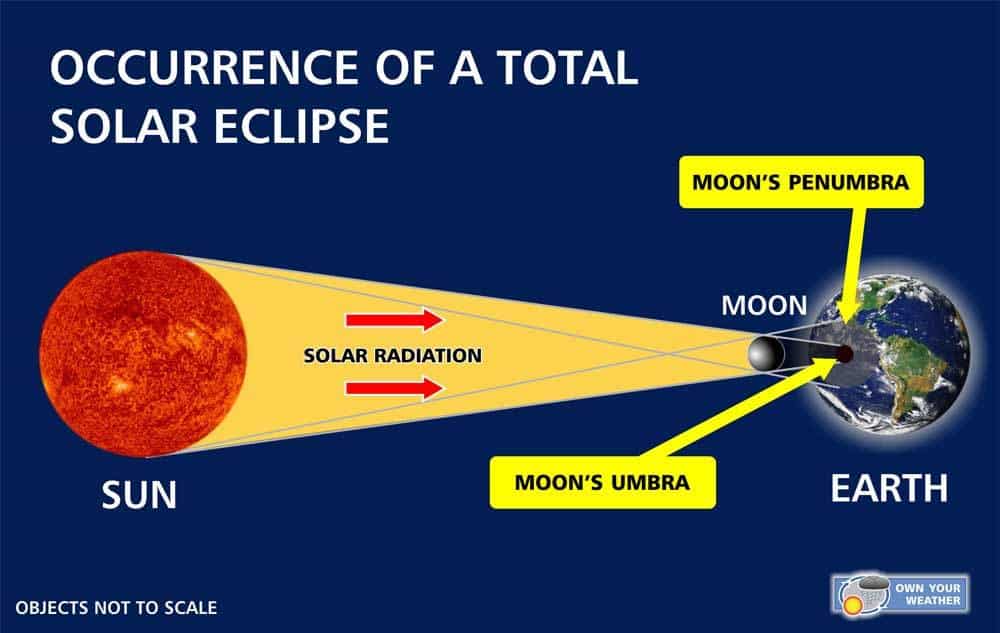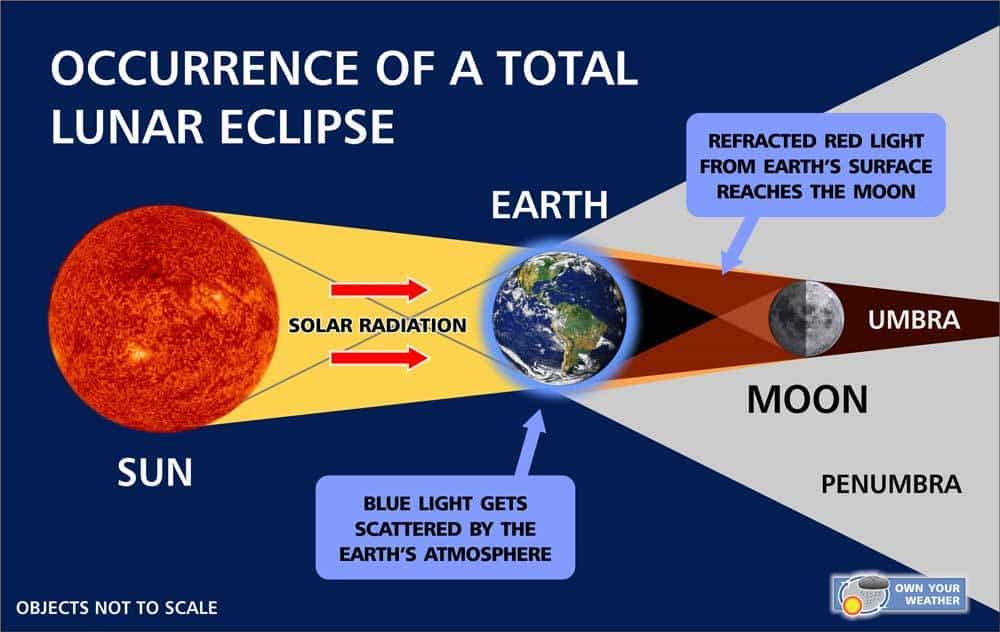What Phase Is The Moon In During A Solar Eclipse? Examining The Difference Between A Solar And Lunar Eclipse

A total solar eclipse is one of the most anticipated & well-known celestial events that has been observed worldwide for centuries. We take a closer look at what it is and how it differs from a lunar eclipse.
A total solar eclipse primarily occurs during the New Moon when the Sun is entirely covered in darkness and not visible from locations on the planet's surface within the Moon's dark inner shadow or umbra. A partial solar eclipse is observed within the Moon's lighter outer shadow or penumbra.
Observations of these almost "supernatural" events date back thousands of years and have been documented as early as 1137 BC in Chinese literature. (A book from the Zhou Dynasty called Zhou-Shu described what is believed to be a lunar eclipse.)
Through the centuries, many cultures and religions have attached much symbolism and importance to these phenomena. Their significance is so widespread across different civilizations through the ages that it justifies a large separate post, but it is still worth noting.
The question in the heading of this article, "What Phase Is The Moon In During A Solar Eclipse," is just one of many frequently-asked questions raised when it comes to a solar or lunar eclipse.
It also illustrates just how involved both the moon and sun are in the occurrence of a solar as well as a lunar eclipse.
And this is what this article will focus on: Explain what a solar eclipse is, what a lunar eclipse is, and how they differ from each other. It will also describe how each process takes place and also look at the effect they have on the weather.
Solar and Lunar Eclipse Definition
Before we answer the question posed in this article's title or even start to examine how a solar and lunar eclipse occurs, we need to establish a clear definition of each event.
Solar Eclipse Definition
Of the two events, a solar eclipse is arguably the most dramatic and spectacular, with the effect of day turning into night within a couple of minutes, only to return to daylight a few minutes later. Not to mention the spectacle of viewing the sun during this event.
(Needless to say, special care should be taken when looking at the sun during a solar eclipse, including special glasses or a dark piece of film.)
Although most of us already experienced a total or partial solar eclipse at some point, it is crucial to understand what exactly this phenomenon is before we can begin to describe how this event occurs:
What Is A Solar Eclipse?
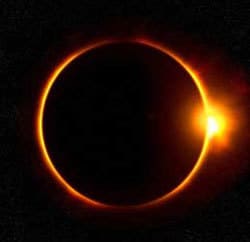
A solar eclipse occurs when the moon's path crosses between the Earth and the Sun, casting a shadow on the planet's surface. The sun is seen as partially or entirely blocked out by the moon from locations on Earth falling within this shadow, which experiences varying levels of darkness as a result.
The most spectacular type of solar eclipse is called a total solar eclipse, which occurs when the moon completely blocks out the sun. This form of solar eclipse occurs very rarely.
A total solar eclipse can be viewed from some viewpoint on the planet appropriately every 18 months. However, it estimated that the time it would take for a total solar eclipse to occur at the exact same location will be roughly between 360 and 410 years.
It is rare since the sun, moon, and earth must be in complete alignment, and the moon must be at the right distance between the sun and earth to completely block out the sun.
The process through which a solar eclipse occurs will be explained in more detail in an upcoming section within this post.
Lunar Eclipse Definition
It may not be as spectacular as a solar eclipse or have such an impact on atmospheric conditions back on earth. However, a lunar eclipse remains a rare and special event that can be visually just as captivating under the right conditions.
Before examining exactly how this event occurs, one needs to establish a clear definition of a lunar eclipse to completely understand this phenomenon first:
What Is A Lunar Eclipse?
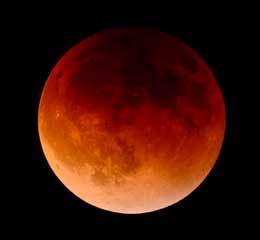
A lunar eclipse occurs when the Earth's orbit crosses between the Sun and the Moon, causing the shadow of the Earth to block a portion of the sunlight from reaching the Moon. Depending on its position, the planet's shadow can result in a partial or total eclipse of the moon.
Like a solar eclipse, the most impressive and visually captivating form of lunar eclipse is a total lunar eclipse. It occurs very seldom, though, approximately once every 2.5 years.
Like a solar eclipse, a total lunar eclipse is only possible when the sun, moon, and earth are incomplete or nearly in perfect alignment. Partial lunar eclipses, however, are a much more common occurrence.
Unlike a solar eclipse which can only be viewed from a specific location on the planet's surface that falls within the moon shadow, it is possible to observe a lunar eclipse from almost anywhere on earth.
With the basic definition of each phenomenon covered, attention can turn to the different processes through which a solar and lunar eclipse occurs.
How A Solar And Lunar Eclipse Occur
From the description of both a solar and lunar eclipse, it is clear that they have a lot in common. Both involve the sun, earth, and moon. The three celestial bodies also need to be near perfect alignment for each phenomenon to occur.
But there are also are distinct differences between the two events, which we will look examine more closely by looking at each process separately.
How Does A Solar Eclipse Occur?
As the moon orbits the earth, the earth rotates on its axis, and both orbit the sun, one can start to understand why a solar eclipse does not occur that often.
Add to this equation the fact that the moon orbits the earth at a different angle and speed than the earth rotates and revolves around the sun, and it's surprising that a solar eclipse is possible to take place at all.
But as most of you know, it does happen. A total solar eclipse can be viewed from some location on the planet appropriately every 18 months, as already mentioned.
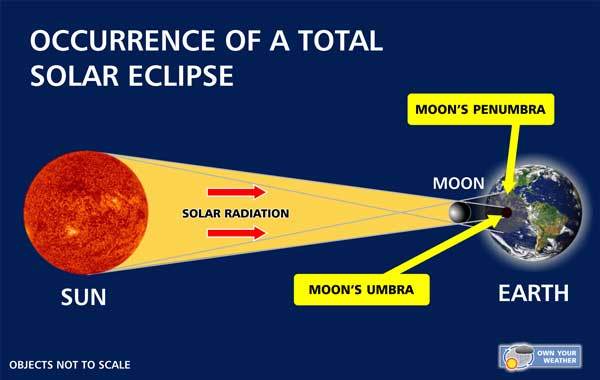
The Process Through Which A Total Solar Eclipse Occur. Click On Image For A Larger View.
During this period, the moon passes between the sun and the earth. As it crosses between the two, it casts a shadow on the earth's surface.
Since the earth rotates, this shadow travels across the planet's surface, creating what is called the path of totality.
A total solar eclipse can only be seen by anyone that is within the path of totality. If you are not located within this path but still relatively close, you will be able to observe a partial solar eclipse.
All solar eclipses only last for a few minutes, with some exceptions where the total length of an eclipse can exceed seven, although this is very rare.
At this point, we come to the question asked in the title of this article:
What Phase Is The Moon In During A Solar Eclipse?
A solar eclipse occurs during New Moon when the Sun is entirely covered in darkness and not visible from Earth. A total solar eclipse is observed within the Moon's dark inner shadow called the umbra. A partial solar eclipse is observed within the Moon's lighter outer shadow called the penumbra.
Types Of Solar Eclipses
Depending on the alignment and distance of the moon between the sun and earth, different forms of solar eclipses can occur. There are four primary types of solar eclipses:
1) Partial Solar Eclipse:
A partial solar eclipse occurs when only a certain percentage of the sun gets eclipsed by the moon. It mostly occurs under one of two different circumstances.
The first type of partial eclipse occurs when the position from where the event is observed falls outside the path of totality.
It means that any observer outside the moon's umbra (dark inner shadow) will only be able to view a part of the sun to be eclipsed.
The second type of partial eclipse occurs when the earth, moon, and sun are not completely aligned. It causes the moon's shadow to miss the surface of the planet.
As a result, the only type of solar eclipse that can be observed in these conditions will be a partial one.
2) Annular Eclipse
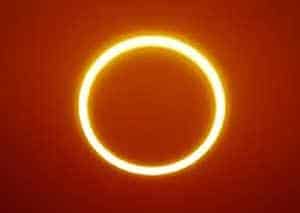
An annular solar eclipse occurs when the diameter of the moon appears smaller than the diameter of the sun and is unable to block it out completely, leaving the outer surface of the sun exposed.
As a result, the sun's outer surface appears like a bright ring in the sky. This form of solar eclipse takes place when the moon is at its furthest point from the earth in its orbital path.
3) Hybrid Solar Eclipse
Also known as an annular-total eclipse, this eclipse occurs when the phenomenon shifts from an annular to a total solar eclipse and vice versa during a single event as it travels along the path of totality on the surface of the planet.
Like a total solar eclipse, this form of eclipse is also only possible when the earth, moon, and sun are in perfect alignment. It is also the rarest of all eclipses and makes up only 5 percent of all solar eclipses combined.
4) Total Solar Eclipse
The most well-known of all eclipses are the total solar eclipse. It occurs when the earth, moon, and sun are in complete alignment, and the moon covers the whole surface of the sun, with just the sun's bright corona (the sun's atmosphere) visible.
In able for observers to view a total solar eclipse, they need to be in the path of totality, described earlier in this post.
How Does A Lunar Eclipse Occur?
The same orbit of the moon around the earth, and both celestial bodies' rotation around the sun that results in a solar eclipse, is also responsible for a lunar eclipse.
In able for a lunar eclipse to occur, the moon must be in its Full Moon Phase (with the whole surface of the moon illuminated.)
The sun, moon, and earth must also be in perfect or near-perfect alignment to allow a lunar eclipse to take place. (The same conditions required for a solar eclipse to occur.)
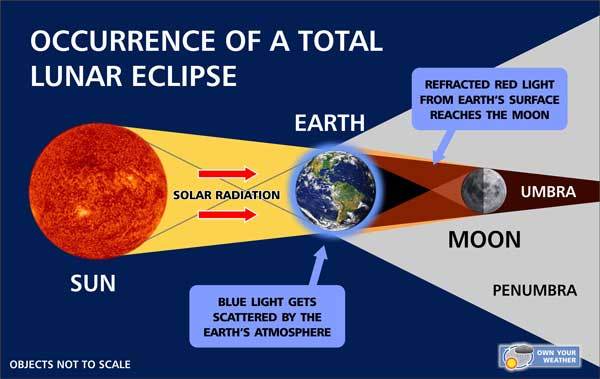
The Process Through Which A Total Lunar Eclipse Occur. Click On Image For A Larger View.
In the case of a lunar eclipse, however, the earth passes between the sun and moon, casting its shadow over the moon's surface.
Unlike a solar eclipse, which can only be observed from a specific location on earth, as already stated, a lunar eclipse can be viewed from almost any region on the planet.
Depending on the exact positioning of the earth, different forms of lunar eclipses can occur. They can be categorized into three primary types of eclipses:
1) Penumbral Lunar Eclipse:
This type of eclipse occurs when the earth's penumbra (light outer shadow) is cast over the moon, causing a slight darkening of the moon's surface, which is sometimes invisible to the naked eye.
2) Partial Lunar Eclipse:
The form of eclipse where a specific portion of the moon falls within the earth's umbra (dark inner shadow). It creates the effect of a particular-sized "bite being taken out of the moon."
3) Central Lunar Eclipse:
The type of eclipse most of us are familiar with where the sun, earth, and moon are perfectly aligned, causing the earth's shadow to block out any light from the sun completely.
The only light that the moon receives during a total lunar eclipse is the faint light refracted from the surface of the Earth.
As a large amount of blue light is scattered while traveling through the atmosphere, it gives the moon a reddish tint. The phenomenon better known as the "Blood Moon" is the result of this process.
Difference Between A Solar And Lunar Eclipse
Throughout this article, we already briefly touched on the majority of differences between a solar and lunar eclipse. The following list was created to provide a summary of the primary differences between the two events:
- A solar eclipse occurs when the moon travels between the earth and the sun, while a solar eclipse occurs when the earth's path crosses between the moon and sun.
- A solar eclipse is only visible from a specific location on earth at any given time, while a lunar eclipse can be observed from almost any point on the planet's surface.
- For a solar eclipse to occur, a New Moon must be present, while a lunar eclipse occurs during a Full Moon.
- A lunar eclipse does not affect the weather, while a solar eclipse has a small and temporary but noticeable effect.
- A solar eclipse is observed during the day, while a lunar eclipse is best viewed at night.
- A lunar eclipse occurs more frequently than a solar eclipse.
- Special care should be taken when viewing a solar eclipse to avoid damage to the eyes, while a lunar eclipse can be safely viewed with the naked eye.
- A solar eclipse has a much more significant effect on human activity since it causes a sudden onset of darkness during the middle of the day, while a lunar eclipse gets observed during the night when it is already dark.
There are other subtle differences between the two events, but the ones listed here are the primary differences between a solar and lunar eclipse.
Effects Of A Solar & Lunar Eclipse On The Weather
Although both phenomena look impressive and significant, they can create the impression that they may have a considerable impact on the earth's atmospheric conditions. This impression is only partially correct.
The moon is already most notable during the evening when the sky is covered in darkness. A lunar eclipse will only result in the darkening of what is already a small light source, so it has little if any effect on our weather.
A solar eclipse, on the other hand, is an entirely different matter. It occurs during the day when the sun is the primary source of light, heat, and other forms of solar radiation that the earth needs to support life on the planet.
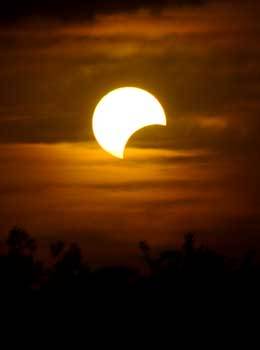
A solar eclipse occurs over minutes where the earth is quickly covered in darkness, rather than the several hours it takes the sun to near the horizon in the afternoon before setting. As a result, there is a slight but relatively quick drop in temperature during this event.
(According to NASA, temperatures can drop 10 - 15° Fahrenheit during a solar eclipse.)
Solar eclipses also have an impact on wind speed and direction. Wind is simply air flowing from an area of high pressure to an area of low pressure. (You can read all about wind and how it is created in this article.)
A low-pressure system near the ground is created as the sun warms the surface, which warms the air above it in turn. As a result, the warm air starts to rise, leaving the air with a lower pressure behind. Wind blows from surrounding high-pressure areas to this location.
During a solar eclipse, the heating of the ground surface slows down, and the low-pressure system is much weaker, resulting in the wind blowing from high-pressure regions to have a much slower speed.
Even though a solar eclipse has some effect on local atmospheric conditions, it is relatively mild and mostly temporary. It is, therefore, safe to state that solar and lunar eclipses have minimal and only temporary effects on the weather.
Conclusion
There is no doubt that a solar and lunar eclipse are both events that capture the public's imagination. A total solar & lunar eclipse are as spectacular as they are rare.
These two occurrences have a lot in common, but as this article illustrated, they also differ in a variety of ways. In a sense, they are two sides of the same coin.
This article explained what a solar and lunar eclipse is and how they occur. It also illustrated how these events differ from each other and how they may affect the weather.
Never miss out again when another interesting and helpful article is released and stay updated, while also receiving helpful tips & information by simply clicking on this link .
Until next time, keep your eye on the weather!

